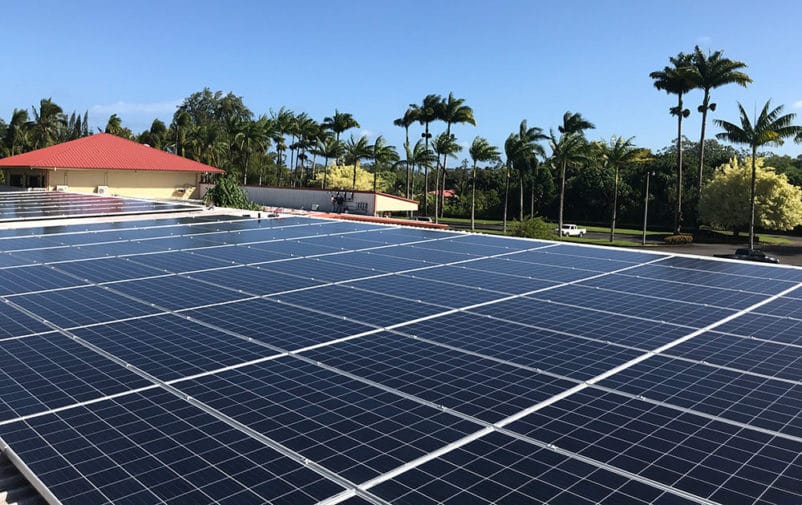The winners of the largest renewable energy procurement ever put forward by Hawaiian Electric Company (Heco) have been announced, bringing with them up to 460 MW of solar energy and nearly 3 GWh of energy storage on Oahu, Maui and Hawaii.
The full scope of the procurement represents a 50% increase of the total solar megawatts on the Hawaiian Electric system.
While we know how many projects will be located on each island and their cumulative capacities, exact sizes and locations of the projects will be made public in 30 days or sooner if some developers start their community engagement efforts immediately. Additionally, each project is still subject to approval by the Public Utilities Commission (PUC).
What goes where
Broken down by island, Oahu will become home to eight solar-plus-storage projects and one stand-alone storage project. These nine installations will total approximately 287 MW of generation and 1.8 GWh of storage. On Maui Island, three solar-plus-storage projects and one standalone will bring roughly 100 MW of generation and 560 MWh of storage capacity. Lastly, on Hawaii, two solar-plus-storage projects and a stand-alone storage project are on the way — totalling approximately 72 MW of generation and 492 MWh of storage.
The procurement of these renewables will help the state conquer two important energy objectives.
Meeting milestones
This new generation and an overall 50% leap in the state’s solar capacity will help bring Hawaii closer to its mandates of 30% renewable power by 2020 and 40% renewable by 2030, before the full mandate of an entirely renewable-powered state by 2045.
The state is already far advanced on meeting these mandates, especially the island of Kauai. On the whole, Hawaiian Electric predicts that its system will reach 31% renewable generation by this December, and could reach 50% by year-end 2022.
Prior to the announcement of this tender, Heco predicted that it could reach 70% renewables by the late 2020s, assuming that the projects eventually selected via this tender are found to be cost effective. These aren’t just wildly optimistic claims, either. In 2018, a consulting put forth an analysis showing that the state’s least-cost path would achieve 46% renewables by 2021, and 58% to 84% renewables by 2030.
As for previously-mentioned Kauai, that island achieved 56% renewable energy generation in 2019, and has logged more than 440 hours at 100% renewable energy since the beginning of 2020. Moreover, the island is expected to reach more than 60% renewable generation by the end of the year, when the AES PMRF solar-plus-storage project is completed.
Renewables for recovery
The other outcome this tender will bring is vast job creation in one of the areas that has been hit hardest by the Covid-19 pandemic. Job creation has always been a key selling point for renewable procurement and that was the same here, however it couldn’t have been known at the time how much the jobs would be needed.
According to the newest analysis of the pandemic’s impact on clean energy employment, by Environmental Entrepreneurs (E2), E4TheFuture, the American Council on Renewable Energy (ACORE) and BW Research, Hawaii has dropped close to a quarter of all clean energy jobs since the onset of the pandemic, with that figure reaching 3,372.
In a recent piece for pv magazine, Allison Hilliard and Will Giese outlined that, even on the lowest end, every MW of utility-scale solar generated creates 3.3 jobs, while the number can get as high as 21.9/MW for commercial installations and 38.7 per MW for residential.
With $21.39 per hour being the base pay for an entry level solar installer in Hawaii, the procurement will directly help those who have lost employment get back on their feet. This all depends on when the projects can begin development and construction. The project timelines predict that those chosen for this procurement will go on-line in 2022. At this point, however, all projects are getting to the point of community outreach, which will likely be delayed.
This content is protected by copyright and may not be reused. If you want to cooperate with us and would like to reuse some of our content, please contact: editors@pv-magazine.com.









By submitting this form you agree to pv magazine using your data for the purposes of publishing your comment.
Your personal data will only be disclosed or otherwise transmitted to third parties for the purposes of spam filtering or if this is necessary for technical maintenance of the website. Any other transfer to third parties will not take place unless this is justified on the basis of applicable data protection regulations or if pv magazine is legally obliged to do so.
You may revoke this consent at any time with effect for the future, in which case your personal data will be deleted immediately. Otherwise, your data will be deleted if pv magazine has processed your request or the purpose of data storage is fulfilled.
Further information on data privacy can be found in our Data Protection Policy.